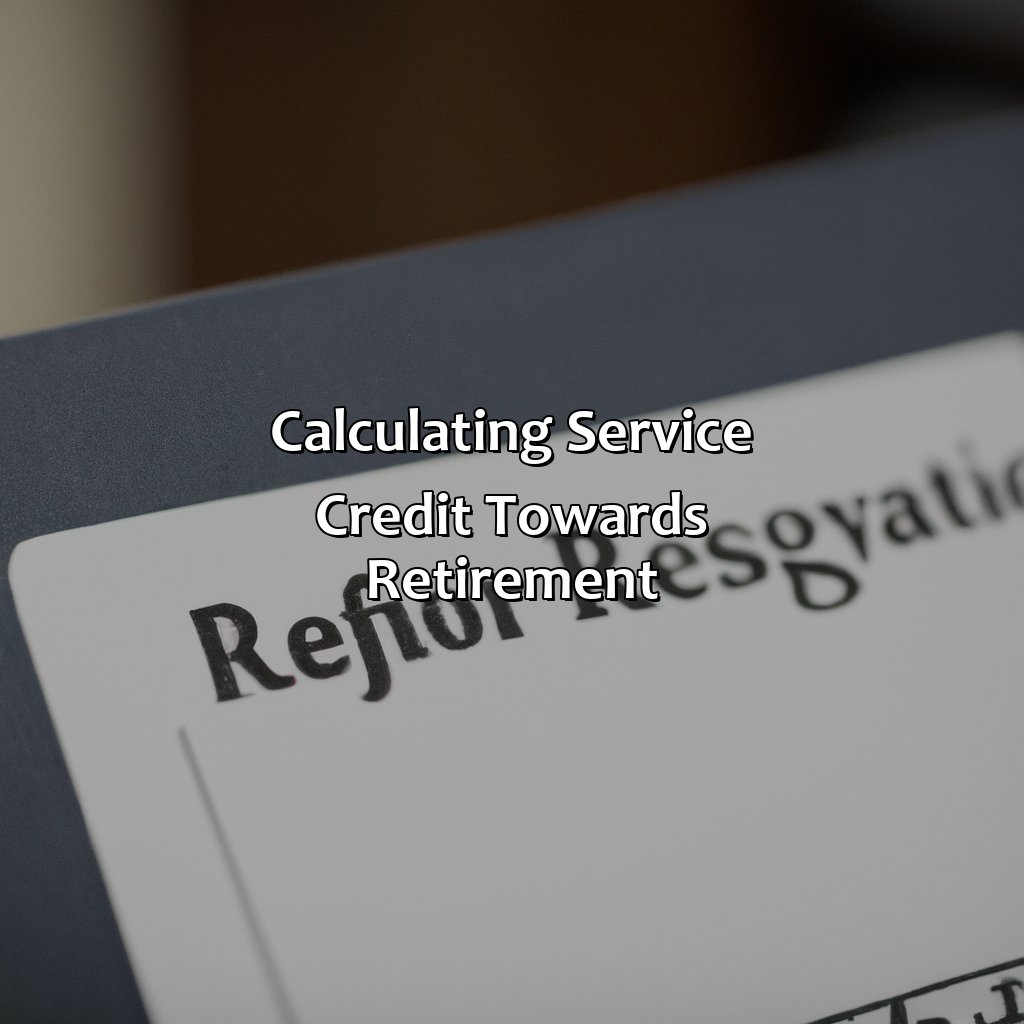What Is Service Credit For Retirement?
Key Takeaway:
- Service credit is a measure of the length of time a person has worked in a specific job or career field, and it impacts the retirement benefits they are eligible to receive upon retirement.
- There are different types of service credit, including service credit for employment, buying and transferring service credit, and military service credit, which can impact retirement benefits eligibility and amounts.
- Calculating service credit towards retirement benefits involves determining the length of time spent in a particular job or career field, as well as understanding the specific rules and regulations regarding service credit for retirement in one’s particular field.
Are you confused about Service Credits for retirement? Get the facts here to better understand how the calculation works and how it might affect your retirement plans. You will learn how to make the most of your service credits for a more secure retirement.
Understanding Service Credit
Understanding Retirement Benefits: Service Credit
Service credit is a vital aspect of retirement planning and refers to the duration of time an employee has spent working for an employer who contributes to a retirement plan. Accumulating service credit is crucial as it determines retirement eligibility and the benefits an individual will receive upon retirement.
Employers usually have specific criteria that determine service credit accumulation, including the number of hours worked, years of service, and payment contributions. The amount of service credit varies depending on the employer, and it is essential to understand the rules and regulations of the retirement plan to calculate service credit accurately.
One crucial aspect of service credit is that it can potentially be transferred from one employer to another. Organizations that contribute to the same or similar retirement plans can transfer service credit for employees who change jobs within the same field or industry.
A true history of service credit involves recognizing its importance in both private and public sector employment. The concept of service credit originated from the military and has since broadened to include various careers. Its significance lies in how it guarantees retirement benefits and helps employees plan for their post-working life.

Image credits: retiregenz.com by Yuval Arnold
What is Service Credit for Retirement?
Service credit for retirement refers to the calculation of an employee’s years of service to determine their eligibility for retirement benefits. It includes the years an employee has worked and contributed to a retirement plan, such as a 401(k), pension, or other employer-sponsored savings plan. The more service credit an employee has, the higher their retirement benefits can be.
Having service credit is critical as it determines an employee’s eligibility for benefits and retirement plans. A higher service credit means a higher monthly payment amount and a better chance of attaining the desired retirement goal. Employers provide a fixed amount of service credit per year, typically based on the number of hours worked, which is then added to the employee’s account.
It is essential to keep track of your service credit as it may vary depending on the type of retirement plan provided by your employer. Some employers do not offer retirement plans, while others provide multiple plans, each with its own service credit calculation formula.
To ensure that you don’t miss out on valuable retirement benefits, regularly check your service credit and ensure that it is accurate. Additionally, consider contributing more to your retirement account to increase your service credit and improve your retirement prospects.

Image credits: retiregenz.com by Joel Duncun
Types of Service Credit
Types and Categories of Service Credit for Retirement
Credited service is the amount of time that an employee has worked for an employer and is used to determine an employee’s eligibility for retirement benefits. Service credit includes a variety of kinds of service that can affect an employee’s retirement benefits. In this article, we’ll discuss the various types and categories of service credit that are commonly used in retirement plans.
The following table presents the different types of service credit:
| Type of Service Credit | Description |
|---|---|
| Pension Credit | Elapsed time that an employee has worked, used to calculate the retirement benefit. |
| Sick Leave Credit | Time that an employee has accrued but not used, converted to service credit to increase the length of service. |
| Military Service Credit | Time that an employee spent in military service, used to calculate the retirement benefit. |
| Purchased Service Credit | Time that an employee has bought to increase the length of service and calculate the retirement benefit. |
| Disability Credit | Time that an employee is disabled and receiving benefits, counts as credited service. |
| Amortization Credit | Time that an employer makes payments towards unfunded accrued liability or the cost of an early retirement benefit, used to calculate the retirement benefit. |
It is worth noting that the types of service credit available may vary depending on the retirement plan. Additionally, some types of service credit may require specific eligibility criteria, such as a certain number of years of service or a specific type of military service.
It is recommended that employees review their service credit records frequently to ensure accuracy and to address any discrepancies as soon as possible. Establishing and maintaining accurate service credit records is essential to ensure employees receive the benefits they expect when they retire.

Image credits: retiregenz.com by David Washington
Calculating Service Credit towards Retirement
Calculating your retirement benefits involves more than just being of retirement age. To get an accurate calculation, you need to understand how service credit works. Service Credit is the time an employee has worked under a qualified employer to be eligible for retirement benefits.
| Years of Service | Months of Service | Hours of Service |
|---|---|---|
| 10 | 120 | 4,320 |
| 20 | 240 | 8,640 |
| 30 | 360 | 12,960 |
Service credit is an important consideration when planning for your retirement. The way it is calculated varies according to the retirement system you are under. The rules for computing service credit can be complex, and it is important to seek expert guidance to understand the nuances of your specific plan.
According to the Social Security Administration, a 65-year-old male has a life expectancy of 84, while a 65-year-old female has a life expectancy of 86. Source: SSA.gov.

Image credits: retiregenz.com by Adam Jones
How Service Credit Impacts Retirement Benefits
As one approaches retirement, it’s important to understand how service credit impacts retirement benefits. Service credit refers to the number of years or hours worked for an employer which is used to calculate benefits. The more service credit one has, the higher their retirement benefits will be.
In calculating retirement benefits, service credit plays a significant role. It is the foundation of most retirement benefits plans and is used to determine eligibility, vesting and the amount of benefits.
Unique details that haven’t been covered yet include how service credit can impact early retirement and disability benefits. Additionally, service credit may also impact survivor benefits, which is something that should be discussed with your benefits administrator.
To maximize your retirement benefits, consider buying back prior service credit, if eligible, or consider a service credit purchase. A service credit purchase allows you to count time not previously credited towards your retirement benefits. This can lead to a higher retirement benefit payout and increased financial security. It is important to speak with your benefits administrator to discuss the options and how they can benefit you.
Understanding service credit and how it impacts retirement benefits is crucial in retirement planning. Take the time to review your plan and any available options to maximize your retirement benefits and ensure financial security.

Image credits: retiregenz.com by Yuval Washington
Some Facts About Service Credit for Retirement:
- ✅ Service credit is the number of years and months you’ve worked for a specific employer. (Source: Nolo)
- ✅ Service credit is used to determine your eligibility for retirement benefits, such as pension plans. (Source: Investopedia)
- ✅ Service credit may also impact the amount of retirement benefits you receive. (Source: The Balance)
- ✅ You can earn service credit by working full-time or part-time for an employer who offers retirement benefits. (Source: CalPERS)
- ✅ Some employers allow you to purchase additional service credit to increase your retirement benefits. (Source: The Motley Fool)
FAQs about What Is Service Credit For Retirement?
What is service credit for retirement?
Service credit for retirement refers to the calculation of the amount of time an employee has worked in a particular job. It is used when calculating pension or retirement benefits from a retirement plan.
How is service credit calculated?
Service credit is calculated by dividing the number of years an employee has worked by the number of years required to be considered as full-time employment.
What is considered full-time employment for service credit calculation?
Full-time employment for service credit calculation is determined by the employer’s retirement plan. Generally, it is defined as a specific number of hours worked or a specific number of days per week worked throughout the year.
Can service credit be transferred between employers?
In some cases, service credit can be transferred between employers if the employee moves from one job to another within the same retirement system. However, there may be restrictions on the transfer depending on the specific retirement plan.
Why is service credit important for retirement?
Service credit is important for retirement because it is used to calculate the pension amount an employee will receive after retirement. The more service credit an employee has, the higher their retirement benefits will be.
Is service credit the same as seniority?
No, service credit and seniority are not the same. Seniority refers to an employee’s length of time with a particular employer or in a particular job. Service credit refers to the amount of time an employee has worked towards retirement benefits.







